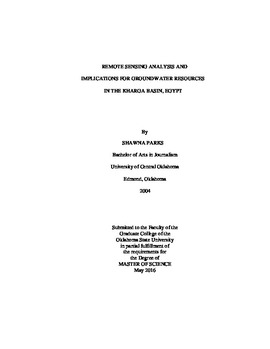| dc.contributor.advisor | Byrnes, Jeffrey | |
| dc.contributor.author | Parks, Shawna Lee | |
| dc.date.accessioned | 2017-02-22T22:16:02Z | |
| dc.date.available | 2017-02-22T22:16:02Z | |
| dc.date.issued | 2016-05-01 | |
| dc.identifier.uri | https://hdl.handle.net/11244/49131 | |
| dc.description.abstract | Identifying new groundwater resources in Africa is important because climate change may cause the Nile recharge to decrease by the end of the century, affecting water stability in the eleven countries that rely on this river as a water source. Further exacerbating the demand for water in Egypt in particular is a growing population that already lives on a small per capita amount of water. I report results from drainage analysis using a Shuttle Radar Topography Mission (SRTM) digital elevation model (DEM) that corroborate evidence suggesting that the Kharga Basin in Egypt's Western Desert is a closed basin that could have held water in the past. Combined with evidence from other studies, this suggests water from Pleistocene humid periods still resides within the Kharga Basin. Fractures possibly facilitate the vertical movement of this groundwater, consistent with vegetation and tufa deposits following fractures in the basin. Thermal inertia analysis, due to its relation to soil moisture, may help locate areas of relatively shallow groundwater, possibly due to the vertical movement of water along fractures. I report results from remote sensing analysis of optical and thermal images (Moderate Resolution Imaging Spectroradiometer, MODIS) used to create thermal inertia images. Furthermore, I report results from remote sensing analysis of optical (Landsat Operational Land Imager) and radar (Radarsat-1) images and DEMs (SRTM and Advanced Spaceborne Thermal Emission and Reflection Radiometer, ASTER) on the fracture intensity and kinematics in the Kharga Basin. The thermal inertia and fracture density maps were combined with previously published hydraulic conductivity and aquifer thickness maps to perform multi-map analysis and determine the best locations for future water wells. The results suggest the southern end of the major north-south fault is the most conducive to shallow groundwater drilling. For all results, I performed digital image processing and spatial analysis using ENVI and ArcMap. | |
| dc.format | application/pdf | |
| dc.language | en_US | |
| dc.rights | Copyright is held by the author who has granted the Oklahoma State University Library the non-exclusive right to share this material in its institutional repository. Contact Digital Library Services at lib-dls@okstate.edu or 405-744-9161 for the permission policy on the use, reproduction or distribution of this material. | |
| dc.title | Remote Sensing Analysis and Implications for Groundwater Resources in the Kharga Basin, Egypt | |
| dc.contributor.committeeMember | Abdelsalam, Mohamed | |
| dc.contributor.committeeMember | Lao Davila, Daniel | |
| osu.filename | Parks_okstate_0664M_14494.pdf | |
| osu.accesstype | Open Access | |
| dc.description.department | Geology | |
| dc.type.genre | Thesis | |
| dc.type.material | text | |
